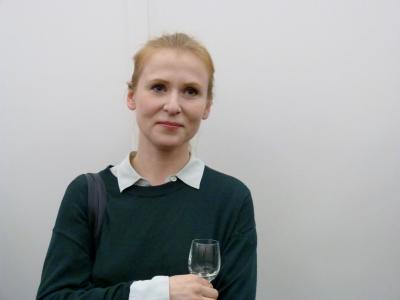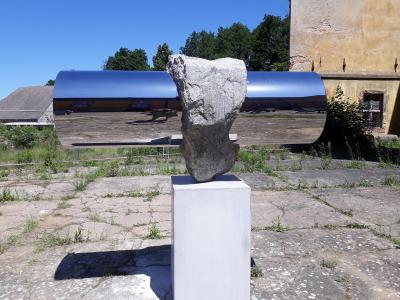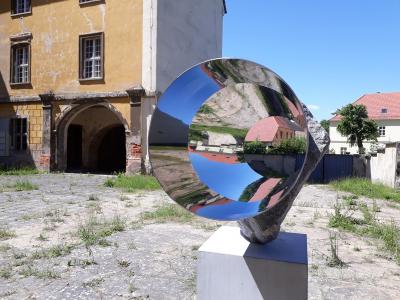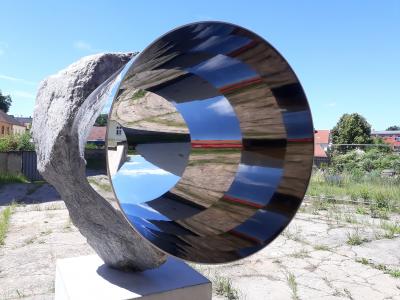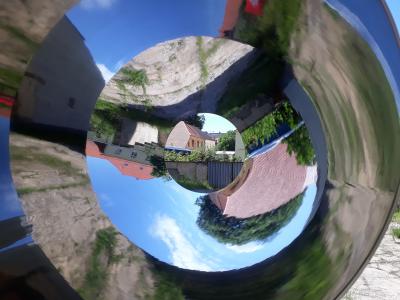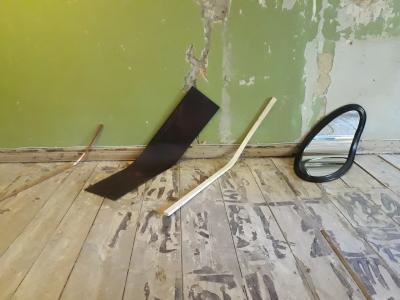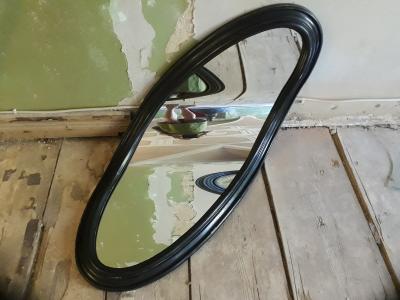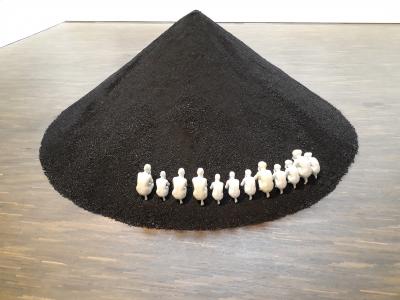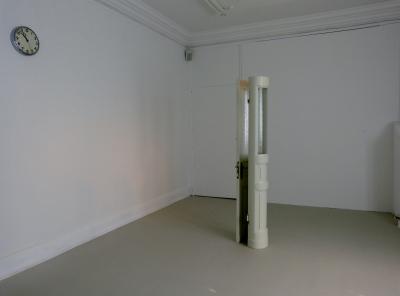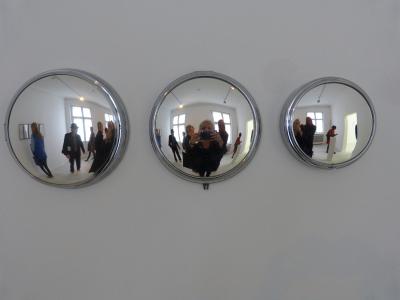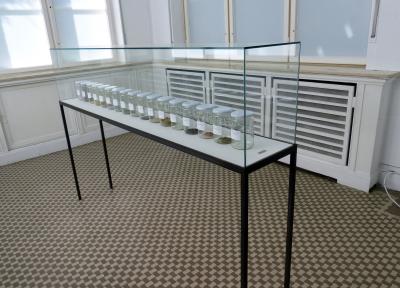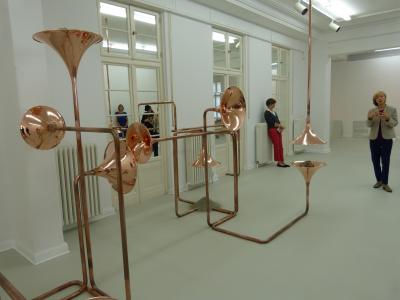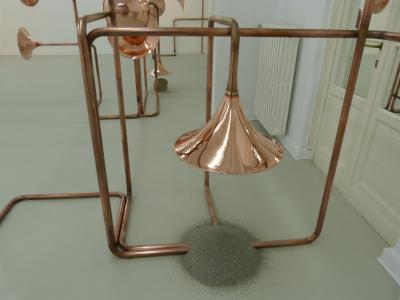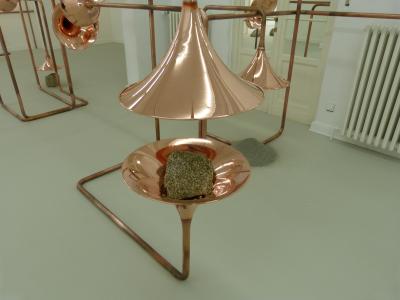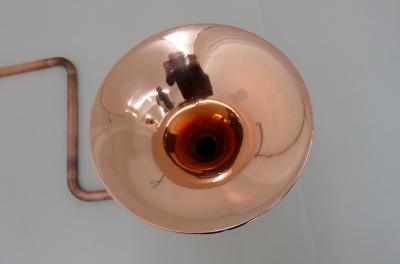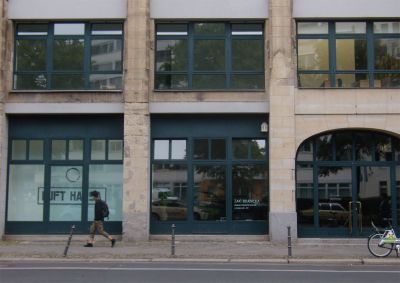Icons, pallets, Mars melons & planets: The artistic wonderland of Alicja Kwade

Clocks, mirrors and stones are just some of the requisites with which Alicja Kwade decorates her ‘magnum theatrum’. Although her work was already considered an insider tip both during and after her studies at the Berlin University of the Arts, it was the Piepenbrock Prize for Sculpture, which she was awarded in 2008, that really gave her the opportunity to present her sensational creations to the wider public, including the art critics. The 29-year-old laureate’s solo exhibition, which was part of the prize, was held from 20 June to 24 August 2008 in the Hamburger Bahnhof – Museum für Gegenwart in Berlin and captivated both the general public and the art world alike. Suddenly, from workroom 15, which was almost 1,300 square meters in size, there emerged an artist who had a really simple way of tackling subjects relating to the infinite validity of obligatory systems, structures and values that the audience could get to grips with straight away. Her exhibition entitled “Von Explosionen zu Ikonen” [“From explosions to icons”] showed how relative the world, its material and immaterial things are: a diamond cut transforms everyday stones found on the street into “kerbstone jewels”; time continues to pass even though the faces of the clocks are covered in a metal coating; an innocuous wooden pallet looks like an antique jewellery piece once restored with a fine brown stain; ground glass bottles of an up-market champagne brand create a nostalgic little green hill; and gilded briquettes mutate into expensive gold bars. And the up-and-coming and yet astonishingly mature sculptor demonstrated yet one more thing at the time - that she can also take a room with a difficult layout flanked by distracting columns and design and use it appropriately.
Self-confessed disbeliever and sceptical observer
Alicja Kwade, who thinks and works in cosmic dimensions, is now well on the way to becoming an international icon of expansive art. It is no wonder really because art for her has always been her natural environment and has played an important role in her family life. Her mother was a professor at the University of Silesia in Katowice / Uniwersytet Śląski w Katowicach, where she taught cultural studies and Slavic studies; her father, a trained restorer, founded and ran the first private gallery for contemporary art in the Silesian metropole. When Alicja was eight years old, she moved to Hanover with her parents and her three-year-old brother Martin. When she was 20, she went to Berlin and studied at the University of the Arts, completing her studies under Christiane Möbus. She then worked as an assistant to the artist Anselm Reyle, but she also worked as a waitress, shoe salesperson and security guide at the Berlinale. And although her thoughts wandered through the cosmos, she had both feet firmly on the ground. Her art, with which she was able to achieve such great success in such a short time, has its basis in a logical and compelling concept based on philosophical and scientific insights. But because Alicja Kwade is a self-confessed disbeliever and sceptical observer of the factual and hypothetical world(s), she does not believe what she see, hears or reads. She simply knows that she does not know what is real, true, constant and immutable. In order to illustrate the fragile perception of things between and among which people live, she creates complex works whose symbolism can be easily deciphered: stones generally embody the earth, when they are shaped into balls they relate to planets; time spins round in the clocks even if they are not recognisable as such at first glance; the mirrors duplicate or multiply lamps, lights and bodies apparently to infinity. The artist also plays with the shape of the objects that she presses, bends or moulds into unexpected poses.
Megagame with mirrors between heaven and earth
Alicja Kwade is a master of alienation and confusion who creates a universe in which you never cease to be amazed. The stages on which she exhibits her curious sculptures are both intimate and, only relatively recently, are places devoted to art which have a long past to look back on, like Schloss Lieberose in the Spreewald for example, the TRAFO Art Gallery in the former power station in Szczecin or the Haus am Waldsee, a single-story villa in Berlin-Zehlendorf which was built at the beginning of the 1920s and in which exhibitions of contemporary art have been held since the end of the Second World War. In the group exhibition Rohkunstbau XXV, which was able to be shown in front of and inside the baroque Schloss Lieberose during the easing phase of lockdown in summer 2020, Alicja astounded with her “Megasubstance” (2020), a pipe polished to a high gloss both inside and out and stuck in a granite setting, which stood in the castle courtyard. Visitors stood in front of it for a long time, walked around this peculiar kaleidoscope and looked at it from all sides and all directions. These perspectives gave rise to surprising views and insights because this was a mega-game with mirrors, concave mirrors and distorting mirrors which reflected the sky, the paving slabs overgrown with weeds, the trees, the surrounding houses and the audience, fragmented them and took them into different constellations. In a subtle way, this interactive work of art demonstrates the connection between people and their environment, and the fluid transitions between heaven and earth that can only be captured in parts, never as a whole.
There is no more light here
Alicja Kwade’s exhibitions always relate to the location - that means that the space available to her is a stage and backdrop for her productions. And because she has a confident sense of space, she incorporates the architectural features, and even the history of the houses where her works are to be set. She works with the spaces in her own special way by taking on and counteracting their original purpose in equal measure. One example of this was Alicja’s first institutional solo show in Poland entitled “Nach Osten” [“Towards the East”] which was held in the TRAFO in Szczecin in 2015/2016. This modernistic power station built in 1912, which is opposite the Gothic church of St John’s and designed in the style of an industrial cathedral, is one of the most important exhibition sites for Polish and international contemporary art in the town on the Oder since it was carefully restored. For the presentation of her earlier video, sound and light installations, the artist transformed the white central hall and the surrounding galleries into a black tower with a pendulum attached at a height of 14 m, the end of which was crowned by a lightbulb. It rotated around its own axis for 24 hours, flashed intermittently, and then faded into the darkness. The brief moments of brightness created an almost supernatural suspense which electrified the visitors. And they felt it all the more because they were having to feel around in the dark in a place where light used to be produced.
Quantum banana & radio powder in a display case
In Berlin, where Alicja Kwade has been living and working for more than 20 years, she has not exactly been spoilt for choice when it comes to exhibitions. Apart from the aforementioned solo exhibition “Von Explosionen zu Ikonen” [“From explosions to icons”] in 2008 and the regular presentations of her art in the König Galerie that represents her, the Haus am Waldsee in Berlin-Zehlendorf organised a retrospective in 2015 entitled “Monolog aus dem 11ten Stock” [“Monologue from the 11th floor”]. That is a few years back now but, irrespective of the time and place, it is indicative of the consistency with which the artist realises her ideas, expands and develops her visual vocabulary without fundamentally changing her subjects. She transformed the bourgeois villa into a multipart curiosity cabinet, into a chamber of wonders with clocks which moved to and fro but always showed two and a half minutes to eleven, or others which, covered with mirrored glass, ticked softly under their smooth surfaces. The objects, which defy their original purpose, also include a rolled door. Their title “Eadem Mutata Resurgo” relates to the logarithmic spiral that occupied the Swiss mathematician and physicist Jakob I. Bernoulli (1654–1705), who made an important contribution to the development of the probability theory. In English, the Latin phrase means: “Although changed, I arise the same”. Alicja Kwade gets to the bottom of terrestrial and cosmic issues by questioning their purpose and exclusivity. She shows that an object is not just square or round; instead, it can be just so or it can be different. Mirrors tarnish by themselves or turn to dust; sometimes branches are real, sometimes they are deceptively real; copper funnels form interconnected vessels under which piles of ground stones lie. The highly polished surfaces of Alicja Kwade’s “Hypothetischem Gebilde” [“Hypothetical structure”] distort what is reflected in them and seem to absorb it whilst the people stand at the edge of the artistic abyss. The artist also creates bronze “Marsmelonen” [“Mars melons”] and “Quantenbananen” [“Quantum bananas”], has radios and bicycles pulverised and exhibits their chemical composition in white-lidded jam jars in museum display cases. Even just having such ideas and visualising them is a very special art.
In diverse universes
Alicja Kwade deals with phenomena that are difficult to understand, convey and demonstrate, although they define and are with us in our day-to-day life from start to finish: space and time and everything that happens there - in this way and in no other way. She takes her inspiration from science, preferably from the theory of relativity. She has a weakness for theoretical constructs whilst mistrusting them at the same time. Time exists in reality although no one can grasp it and so no one can understand it properly. It never stays still and always moves forward and vanishes. Why is it measured in this way and not in any other way? - that is the question posed by Alicja Kwade. There could be a different way of measuring time, a different structure of time – and if so then which? The systems that underlie our life have been conceived and have mutated to become the norm in order to organise our life and make it more manageable. Are these structures unique and eternal – or could others exist as well? Is the reality, i.e. the world, that we move in singular or are there parallel universes as well?
Paradox manuscripts
You do not have to know anything about the space-time curvature, the twin paradoxes or the wormholes to be able to enjoy the ambivalent and paradox world of this artist. It is a world of simple and familiar things - things that are so recognisable to us that we do not have to think about their functionality and their purpose and, for that reason, are astonished when they appear in a different form: bent, dismantled into individual parts and pulverised. Another theme that Alicja has explored since 2006 is the uniqueness and singularity of the individual. She copied out manuscripts of famous or not so famous people in her own hand, including a letter from the inventor physicist and electronic engineer Nikola Tesla (1856–1943), changed his first name slightly and had the result appraised and certified by a Munich graphologist. And look what happened: he certified that the writer of the letter was male and middle-aged, had a sense of humour, has a tendency to be excessive and wasteful, in short, the writer had a “creative and vibrant personality.” The four-part paper “Beeing Nicola Tesla” is clear evidence of the fact that Alicja Kwade, whose first name is pronounced with an s outside Poland, goodness knows why, could be Tesla’s present-day doppelganger, Alisja. Several such letters from the series “Beeing…” were presented in the Neuen Berliner Kunstverein under the German title “Sein...” in 2018. The question of identity will also be at the centre of her exhibition “In Abwesenheit” [“In absentia”], which will hopefully open at the Berlinischen Galerie – Museum für Moderne Kunst on 18 September 2021 after being postponed several times due to the pandemic. The exhibition, as stated on the website, “is based on the more recent works of Alicja Kwade, which can be read as self-portraits in the broader sense. Kwade examines the question of how a person and their physical presence in the room can be described: via their own heartbeat, their individual DNA code or through the chemical elements which make up the person.”
ParaPivot on a rooftop in New York
Because Alicja Kwade has been one of the most in-demand artists for many years and the leading museums in Germany and around the world are desperate to secure her, she keeps a large studio in Berlin-Oberschöneweide, where she employs almost 20 staff – and has enough space to store her finds, such as stones, clocks, branches, pallets, and all the things she needs to make her objects and object groups as they become more and more voluminous. In 2019, her sculptures “ParaPivot I and II” were able to be admired in the rooftop garden of the Metropolitan Museum of Art in New York, a sort of walkable and open astrolabe consisting of several intersecting steel frames upon which nine spheres (planets), attached as if by a miracle, hang as if gravity had forgotten them. This airy construction also opened up unimagined views of the New York skyline, the fragments of which can be viewed within a different frame each time. A framed, real, urban landscape in the open air serving as a series of pictures; that is a work of art without equal.
Causal consistency in Neuss & what is yet to come
Alicja Kwade’s exhibition “Kausalkonsequenz” [“Causal consequence”], which opened at the beginning of September 2020 in the Langen Foundation and will remain open until the start of August 2021, extends outside, inside, on the lawn, in and on the water. The spheres that weigh a ton and are made of sandstone, mirrors, branches and anti-branches etc., enter into a dialogue with the transparent and floating architecture of the Japanese Tadao Ando to produce a multi-layer, almost ethereal total artwork that looks different at different times of the day and year and with every new inspection, rotation and line of sight.
After Alicja Kwade used her stagings in, on and around the museums and other art spaces to demonstrate that she can design and cast a spell over every space perfectly and with much esprit and can use reflections to expand them apparently infinitely, there is one space that she has not yet tried: that of the opera. An inevitable causal consequence requires her presence on the boards that represent this parallel world. And because Alicja has what it takes to be a talented stage designer, her success is guaranteed there too.
Urszula Usakowska-Wolff, February 2021
Interview with Alicja Kwade (by Urszula Usakowska-Wolf):
http://www.kunstdunst.com/als-kuenstlerin-gebe-ich-mir-formal-keine-einschraenkungen-alicja-kwade-im-gespraech-mit-urszula-usakowska-wolff/
More about Alicja Kwade: König Galerie
